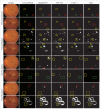MSLF-Net: A Multi-Scale and Multi-Level Feature Fusion Net for Diabetic Retinopathy Segmentation
- PMID: 36552925
- PMCID: PMC9777401
- DOI: 10.3390/diagnostics12122918
MSLF-Net: A Multi-Scale and Multi-Level Feature Fusion Net for Diabetic Retinopathy Segmentation
Abstract
Diabetic Retinopathy (DR) is a diabetic complication that predisposes patients to visual impairments that could lead to blindness. Lesion segmentation using deep learning algorithms is an effective measure to screen and prevent early DR. However, there are several types of DR with varying sizes and high inter-class similarity, making segmentation difficult. In this paper, we propose a supervised segmentation method (MSLF-Net) based on multi-scale-multi-level feature fusion to achieve accurate end-to-end DR lesion segmentation. MSLF-Net builds a Multi-Scale Feature Extraction (MSFE) module to extract multi-scale information and provide more comprehensive features for segmentation. This paper further introduces the Multi-Level Feature Fusion (MLFF) module to improve feature fusion using a cross-layer structure. This structure only fuses low- and high-level features of the same class based on category supervision, avoiding feature contamination. Moreover, this paper produces additional masked images for the dataset and performs image enhancement operations to ensure that the proposed method is trainable and functional on small datasets. The extensive experiments are conducted on public datasets IDRID and e_ophtha. The results showed that our proposed feature enhancement method can perform feature fusion more effectively. Therefore, In the end-to-end DR segmentation neural network model, MSLF Net is superior to other similar models in segmentation, and can effectively improve the DR lesion segmentation performance.
Keywords: diabetic retinopathy; feature fusion; image segmentation; multi-level; multi-scale.
Conflict of interest statement
The authors declare no conflict of interest.
Figures










Similar articles
-
HFCF-Net: A hybrid-feature cross fusion network for COVID-19 lesion segmentation from CT volumetric images.Med Phys. 2022 Jun;49(6):3797-3815. doi: 10.1002/mp.15600. Epub 2022 Mar 30. Med Phys. 2022. PMID: 35301729 Free PMC article.
-
Multi-lesion segmentation guided deep attention network for automated detection of diabetic retinopathy.Comput Biol Med. 2024 Dec;183:109352. doi: 10.1016/j.compbiomed.2024.109352. Epub 2024 Nov 5. Comput Biol Med. 2024. PMID: 39504782
-
Prior-guided attention fusion transformer for multi-lesion segmentation of diabetic retinopathy.Sci Rep. 2024 Sep 8;14(1):20892. doi: 10.1038/s41598-024-71650-6. Sci Rep. 2024. PMID: 39245695 Free PMC article.
-
EIU-Net: Enhanced feature extraction and improved skip connections in U-Net for skin lesion segmentation.Comput Biol Med. 2023 Aug;162:107081. doi: 10.1016/j.compbiomed.2023.107081. Epub 2023 May 29. Comput Biol Med. 2023. PMID: 37301097 Review.
-
PMJAF-Net: Pyramidal multi-scale joint attention and adaptive fusion network for explainable skin lesion segmentation.Comput Biol Med. 2023 Oct;165:107454. doi: 10.1016/j.compbiomed.2023.107454. Epub 2023 Sep 12. Comput Biol Med. 2023. PMID: 37716246 Review.
Cited by
-
SFMANet: A Spatial-Frequency multi-scale attention network for stroke lesion segmentation.Sci Rep. 2025 Jul 8;15(1):24560. doi: 10.1038/s41598-025-10506-z. Sci Rep. 2025. PMID: 40629085 Free PMC article.
-
Level-set based adaptive-active contour segmentation technique with long short-term memory for diabetic retinopathy classification.Front Bioeng Biotechnol. 2023 Dec 19;11:1286966. doi: 10.3389/fbioe.2023.1286966. eCollection 2023. Front Bioeng Biotechnol. 2023. PMID: 38169636 Free PMC article.
References
-
- Danaei G., Finucane M.M., Lu Y., Singh G.M., Cowan M.J., Paciorek C.J., Lin J.K., Farzadfar F., Khang Y.H., Stevens G.A., et al. National, regional, and global trends in fasting plasma glucose and diabetes prevalence since 1980: Systematic analysis of health examination surveys and epidemiological studies with 370 country-years and 2·7 million participants. Lancet. 2011;378:31–40. doi: 10.1016/S0140-6736(11)60679-X. - DOI - PubMed
-
- Atlas I.D. A review of studies utilising retinal photography on the global prevalence of diabetes related retinopathy between 2015 and 2018. Thomas RL, Halim S, Gurudas S, Sivaprasad S, Owens DR. Diabetes Res. Clin. Pract. 2019;157:107840. - PubMed
-
- Wilkinson C.P., Ferris F.L., III, Klein R.E., Lee P.P., Agardh C.D., Davis M., Dills D., Kampik A., Pararajasegaram R., Verdaguer J.T., et al. Proposed international clinical diabetic retinopathy and diabetic macular edema disease severity scales. Ophthalmology. 2003;110:1677–1682. doi: 10.1016/S0161-6420(03)00475-5. - DOI - PubMed
-
- Bellemo V., Lim Z.W., Lim G., Nguyen Q.D., Xie Y., Yip M.Y., Hamzah H., Ho J., Lee X.Q., Hsu W., et al. Artificial intelligence using deep learning to screen for referable and vision-threatening diabetic retinopathy in Africa: A clinical validation study. Lancet Digit. Health. 2019;1:e35–e44. doi: 10.1016/S2589-7500(19)30004-4. - DOI - PubMed
LinkOut - more resources
Full Text Sources

